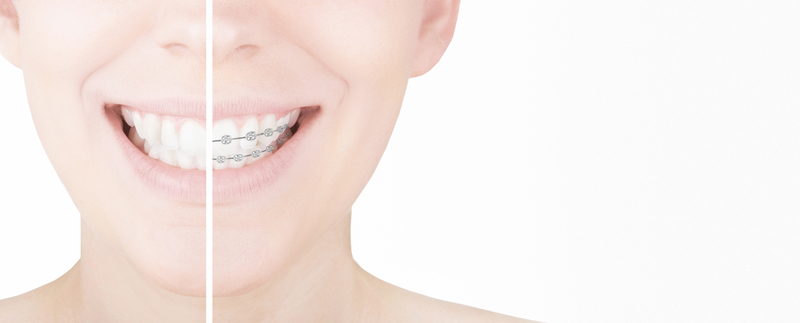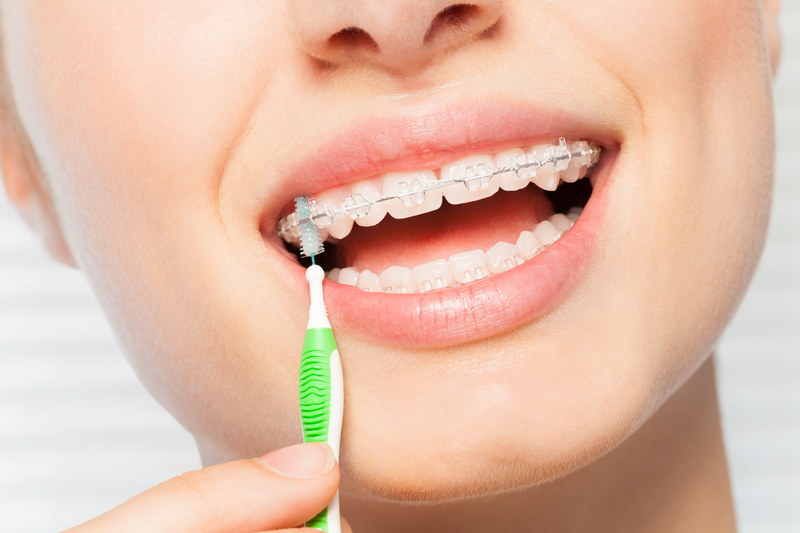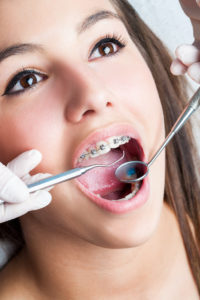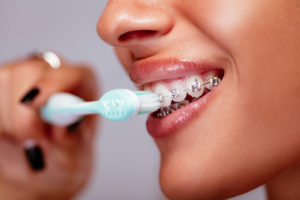The Impact Of Straight Teeth On Oral Health

Many orthodontic patients use braces so that they can have straight teeth, but that’s not the only reason why orthodontic care is so important. Having straight teeth can minimize the likelihood of tooth decay and tooth loss while improving your bite, which affects your ability to chew and speak. Correcting crooked teeth can also improve your oral hygiene and strengthen teeth. Learn more about the positive effects that straight teeth can have on your oral health through this guide!
How Straight Teeth Can Help You
One of the main goals of braces is to create a straight smile and correct any orthodontic issues that may prevent teeth from remaining straight. While orthodontics does focus on straightening patients’ teeth, this is not the only purpose of receiving orthodontic care. Whenever a patient has malocclusion, or bad bite, caused by crowded or crooked teeth, daily oral hygiene can become a difficult task. Malocclusion can also stem from teeth that are out of alignment, or jaws that do not meet properly. Thumb sucking or accidents to the teeth can also cause malocclusion. As oral hygiene becomes more difficult to maintain, the likelihood of dental complications, such as tooth decay, periodontal disease, and tooth loss, increases. An improper bite that goes unaddressed can negatively affect chewing and speaking, and wear down tooth enamel. Correcting these problems is of utmost importance to your orthodontist as they seek to give you the best care possible. Orthodontic care that helps straighten teeth can decrease and ultimately eliminate the chances of any of these complications from arising. With straight teeth, patients can better brush and floss their teeth, which will help strengthen them, while easily monitoring any changes that may occur.
What To Expect With Orthodontics
As you begin your orthodontic treatment, there are a few tips that you should know to prepare yourself for what will be expected of you during your time with braces. Although there are some challenges with straightening adult teeth versus children’s teeth due to the pliability of the jawbone, modern technology allows any adult of any age the opportunity to correct crooked teeth with remarkable success. You will first meet with an orthodontist for an evaluation and orthodontics consultation to determine what option is best for your mouth. Any oral health issues, such as gum disease, will have to be resolved before you can begin treatment. Adults have a variety of options to choose from for their orthodontic care, with many discreet options, such as ceramic or clear braces, lingual braces, and Invisalign clear removable retainers, that are available for your needs.
For children, treatment is similar to that of adults and can start as early as the age of 7. Having an orthodontic examination early on can prevent the progression of orthodontic issues that are present and allow the orthodontist to monitor the development/eruption of teeth. Aesthetically-minded treatment options, such as incognito lingual braces, are available for young children who may be self-conscious about their orthodontic care. Most children and adults can expect treatment for 1-3 years, followed by a period of time in which a retainer will be used to keep teeth in their newly aligned positions. Regular dental and orthodontic visits will be necessary to track the progress of teeth and manage any plaque or tartar buildup that could accrue between teeth.
How To Keep Your Straight Teeth Healthy
Once you or your child finishes orthodontic treatment, it is important to continue certain oral health standards to maintain the health of your gums and teeth. Eating a healthy diet, with or without braces, while limiting the amount of sugary foods you consume, will prevent plaque that can stain or damage your teeth. Brushing with fluoride toothpaste and flossing each day will also prevent any plaque buildup, prevent cavities, and keep your teeth clean. Good oral hygiene is especially important for patients wearing braces because you are more susceptible to plaque buildup around brackets and underneath wires. For additional protection, consider using a mouth guard while playing any sports or activities that could damage your mouth, if hit. Creating a good oral health regimen before you start orthodontic treatment will help you have a healthy mouth during and once braces are removed.
For more information on the importance of straight teeth on oral health and what you can do to get the straight teeth that you want, call Belmar Orthodontics at (303) 225-9016! If you’re ready to change your smile for the better, our team is ready to help you reach that goal for you and the rest of your family!
Preventing Cavities During Braces

Braces is an exciting time for getting that straight smile you’ve always wanted. The not-so-exciting part about braces though, is that they give you a greater risk for cavities. Because there are appliances attached to your teeth, they can become havens for bacteria and plaque buildup. Proper oral hygiene, avoiding certain foods can help you prevent cavities during your time with braces!
Your First Orthodontic Appointment
Finding cavities before you get braces is key to ensuring that you have a healthy smile before getting brackets and wires on your teeth. With braces, you will meet often with your orthodontist to have your braces adjusted. However, you still need to go to your dental appointments to make sure you don’t have cavities during braces.
Traditional metal braces, ceramic braces and lingual braces all have brackets and wires that go on your teeth. Before you get fitted for these braces, you will have dental x-rays taken by the dentist to detect cavities. It’s very important to get your exam so tooth decay is detected. Otherwise, you could end up with large cavities during braces. If cavities are found, they must be fixed before we put your braces on.

Oral Hygiene Is a Must
The status of your smile and your oral health will depend on what you do once you get your braces. The American Dental Association recommends brushing your teeth at least twice a day and flossing 1-2 times. That recommendation is for patients who don’t have braces. When you have braces, you have to be extra meticulous with oral hygiene practices and you will have to do them more than you used to. That means, brushing after every single meal if you can.
To avoid cavities during braces:
- Brush your teeth after every meal. Use a soft-bristled toothbrush with fluoride toothpaste, and brush for 2 minutes every time, making sure to go in all different directions to dislodge food.
- Floss your teeth. This is a habit many people skip with braces because it takes a bit more time. However, it’s time well spent. Floss at least twice a day, using threadable floss. This kind of floss allows you to thread it through the spaces between your teeth, pulling it through so you can floss like normal. It makes flossing a breeze and helps prevent cavities during braces.
- Use orthodontic cleaning tools. A waterpik is a great water-spraying tool that can help you dislodge stuck food. A braces brush (that looks like a Christmas tree brush) can get food out of brackets.
- Watch what you eat! More sugar means more cavities during braces. Limit how much sugar you eat. You want to avoid sticky, sugary foods such as taffy, Starbursts, dried fruit, gummies, fruit snacks, caramels, and anything similar.

Developing Cavities During Braces
Sometimes, tooth enamel is simply weak and tooth decay happens, despite all your hard effort to avoid cavities. When you eat, sugars in your food mixes with mouth bacteria to create plaque. That plaque sticks to your teeth and slowly eats it away, creating decay. You only need plaque stuck in the right place to develop cavities during braces. When you have hidden tooth decay, you may start to feel symptoms such as a toothache, tooth sensitivity or pains with hot and cold. When you see these signs, get dental x-rays taken to see if you have cavities during braces.
If there is a cavity, you actually can have it fixed even if you have braces. It all depends on where the decay is. In most cases, cavities during braces can be fixed because many will lie on surfaces not covered with brackets or wires. You would have the decay drilled out and filled as you normally would. However, if you have a band on your teeth or brackets and wires right where decay is, we would have to remove the bracket or wire while you get it fixed at the dental office. We would then have you come back to our office to get your dental appliance reattached. Patients can sometimes develop such severe cavities during braces that they will need root canals. However, if you are taking care of your teeth, you won’t ever have to worry about that.
Best Option to Avoid Cavities
If you are worried about cavities during braces or have seen a family member get cavities during braces, then getting braces might make you nervous. However, no matter what braces option you choose, the benefits of a straight, beautiful smile can last a lifetime. It’s definitely worth it to get braces; you will just have to be careful to take care of them. If cavities during braces are a concern, consider the benefits of using Invisalign aligners. This is one of our most popular orthodontic options for teens and adults because it is a hidden option for straightening your teeth.
Invisalign transparent aligners are a series of custom-made aligners (like retainers) that fit incredibly snug to your teeth. We take digital calculations of your mouth, where we then design transparent aligners around the shape of your teeth and where we want them to be 18-24 months from that time. Each week, you will switch to a new aligner, which will slowly put pressure on different areas of your mouth, shaping the teeth into a straight line. The aligners are clear and designed to be virtually unnoticeable on your teeth.
When it comes to cavities during braces, you are the one that decides if you will get them with this orthodontic option. That’s because that are completely removable for eating, drinking, flossing and brushing your teeth. It takes less time to brush and floss because of this and there are no appliances on your teeth. This can reduce your risk for cavities during braces, especially if you already know that you have weak tooth enamel. For any questions about cavities during braces, call Belmar Orthodontics at (303) 225-9016!

